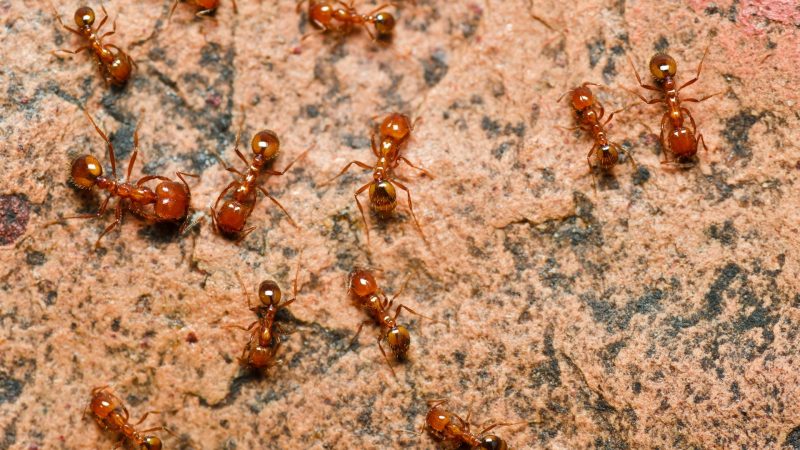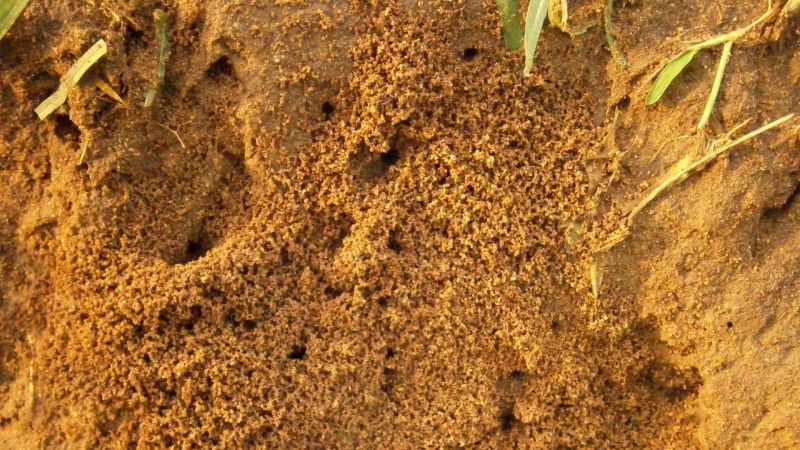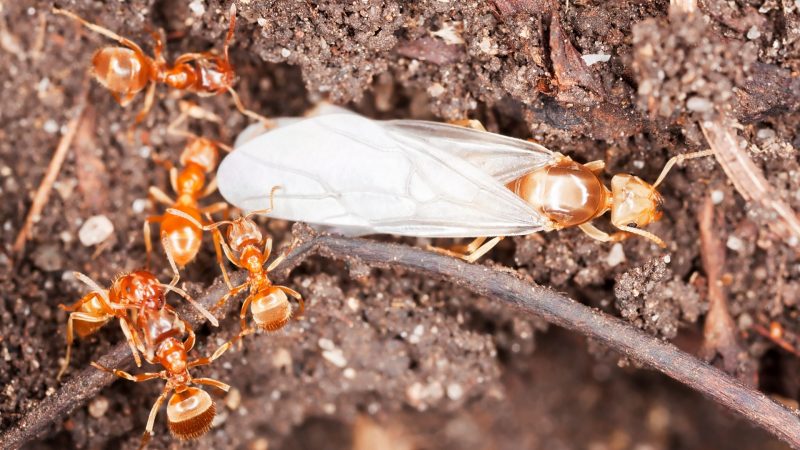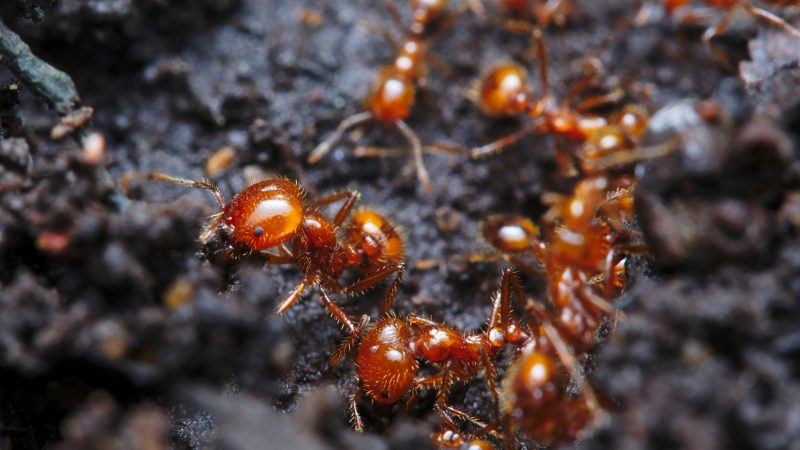A fire ant colony can cause several damage to land and animals. In addition, it can cause various health problems, so it’s crucial to get rid of them.
But, what’s a fire ant colony? A fire ant colony is a community of fire ants wherein there are single or multiple queens. Moreover, a single queen colony is highly territorial with a population limit of 150 mounts, comprising seven million ants per acre. The multiple queen colonies are receptive and allow 300 mounds with 40 million ants per acre.
These ants are social pests and prefer to live in open areas, such as lawns, meadows, pastures, playgrounds, and parks. Fire ants can destroy your yard in a short period, so getting rid of them early is a must.
Is an Ant Colony a Complex System?

An ant colony is a complex system. They’re composed of three castes—the queens, males, and workers. Each caste has a particular task, contributing greatly to its community.
The colony life offers ants a great advantage as it can dramatically increase their protection as a group. In general, each colony has only one queen, but this isn’t the case in the fire ant colony.
As discussed briefly above, the fire ant colony can either have single or multiple queens. The ant queen or queens only spend their life laying eggs, while the worker ants look for food and take good care of the queen.
Furthermore, they also take care of the queen’s offspring, defend the anthill, maintain their nest, and build galleries. Meanwhile, the male’s only job is to fertilize the queens.
Fire Ant Lifecycle
Fire ant queens deposit eggs, which develop into larvae that resemble grubs. Larvae go through four developmental stages before molting into pupae, which, despite being pale in color and immature, resemble adult fire ants. As they grow, the pupae’s color darkens, and they eventually molt one more time to become adults.
The majority of larvae grow into tiny, female workers without wings. They look for food for the queen while raising the young. Some larvae grow into larger, wingless male adults or mature females capable of reproducing. Future queens of fresh colonies are the female reproductives.
What Types of Ants Live in the Colony?
Queen – Leader of the colony. Her primary function is to serve as the colony’s egg-laying factory, producing up to 1,500 eggs every day for two to seven years. She is fed by worker ants and guarded against predators in her nest, which is hidden deep within the colony.
Worker ants – females without wings and infertile. The mound’s construction and upkeep, the colony’s defense against attackers, and—most importantly—the queen’s and the colony’s feeding are all their responsibilities.
“Alates” or “reproductives,” which are wingless fire ants, remain in the colony until it’s time for a “nuptial” (mating) flight. Prior to waiting for the females in the air, the men take off first. After emerging from the mound, the female alates (virgin queens) fly to meet a waiting male where they mate in the air. The newly fertilized queens locate a location to build a new nest, lose their wings, and establish new colonies.
How Deep Are Fire Ant Colonies?

The fire ants’ nest tunnels have been discovered to be 10 ft. in depth. However, some tunnels are shallow than others, beginning just below the surface of the soil. The colonies situated in clay soils have deeper tubes compared to those in sandy soils.
How Big Are Fire Ant Colonies?
The average fire ants colony comprises 100,000 to 500,000 workers, in addition to hundreds of winged ants and queens. Queen ants can live for seven years or more, while worker ants generally survive for five weeks.
The average number of mounds per acre for sole queen nests appears to be 20 to 50, and for multiple queen nests, up to 250-700. Imported red fire ants develop colonies that mature at a rate of 80,000 workers on average, while colonies as large as 240,000.
How to Destroy Fire Ant Colonies?
Fire ant colonies are destructive to have around the home, particularly in the garden. So, we’ve listed some remedies that you can use to get rid of the fire ant colonies on your property.
Dish Soap
Detergent or dish soap is highly deterrent to ants due to its chemical content. This remedy can break down the ants’ exoskeleton layers, causing them to be dehydrated.
To make the solution:
Step 1: Get a clean spray bottle.
Step 2: Mix the dish soap or detergent and water.
Step 3: Spray the mixture to the ants’ entry points.
Lemon Water
Although lemon water can’t kill fire ants, it’s a good ant repellent. Its strong scent can disrupt the trails of the odor they leave for their fellow ants. In such a way, it’ll be hard for the next batch of ants to follow any paths, as the intoxicating aroma of lemon will deter them from making a new one.
To make the lemon water:
Step 1: Put some lemon juice in a spray bottle.
Step 2: Mix the lemon juice with the same amount of water.
Step 3: Shake the solution slightly and spray it regularly to the affected areas.
Cayenne Pepper
One of your best shots in exterminating fire ants is sliced cayenne pepper or powder. You can sprinkle cayenne pepper or cayenne powder directly into the affected areas, or make a mixture of the two.
To create a mixture:
Step 1: Boil a quart of four to five cayenne pepper powder and slice cayenne peppers.
Step 2: Transfer three to five sliced cayenne peppers to a large container and put boiling water over them.
Step 3: Leave the mixture for at least 24 hours for the best result.
Step 4: Remove the peppers and prepare to exterminate the fire ants.
Step 5: Before using the mixture, sprinkle the cayenne powder around the colony to prevent them from fleeing. It’ll also make the anthill tumbledown.
Step 6: Once done, spray the mixture you’ve made around the areas where ants live and wait for the result.
Diatomaceous Earth (Food-Grade)
Diatomaceous Earth is one of the best repellents for ants. It is made from phytoplankton fossilized remains that can cut through the exoskeletons of ants, drying out their bodies and causing them to die.
For application:
- Sprinkle a thin layer of the food-grade DE under the cabinets, on window sills, and around your trash cans. Make sure to also put it throughout the areas where you spot ants.
- Apply DE once a day until your ants’ problems are gone.
- Natural Product - Composed of 2lbs of 100% ground freshwater...
- OMRI Listed - Listed with the Organic Minerals Research...
- Powder Duster Included - Powder duster in the bag for easy and...
- Supports a Great Cause - Harris donates 10% of profits to support...
- Made in the USA – Mined in Nevada and packaged in Georgia
Vinegar
Vinegar is one of the must-have solutions when it comes to getting rid of ants. Due to its acidity and strong smell, ants dislike vinegar so much. This also erases the scent trail they’ve made, making it hard for the next ants to follow any tracks.
Follow the simple steps below, and you’ll have your vinegar spray solution.
Step 1: Get a clean bottle spray and fill it with 50 water solution and 50 vinegar solution.
Step 2: Slightly shake the solution and spray it directly on the ants.
Step 3: Once done, get a damp paper towel and wipe them with, then discard.
You can also pray the remaining vinegar-water solution on your doorways, windowsills, and in areas where the ants are frequent.
Mint
Planting peppermint around your house can repel insects, particularly ants, on your property. Its minty scent wards off these nuisances from breeding on our property. You can also opt for peppermint oil and spray it on areas where you see ants.
To make a mixture:
Step 1: Get a clean spray bottle.
Step 2: Fill it with half water, and put three to four drops of peppermint oil on it.
Step 3: Once done, use it to spray on the surrounding areas of your home or directly to ants. You may drop some amount of peppermint oil on cotton balls and in places where ants are most common.
- 100% Pure & Natural Peppermint Essential Oil - Artizen Essential...
- Don' t Fall Victim To Cheap Diluted Peppermint Oil - Many...
- Most 4 Ounce Peppermint Oils Contain Less Than 1/3 Of Natural Oil...
- High Quality Glass Bottles With Eyedropper - We use premium glass...
- Lifetime Warranty - Artizen Essential Oils offers a lifetime...
How to Get Rid of Fire Ant Colonies in Your Yard?
The most common and effective method for getting rid of colonies in your yard is the application of the two-step method.
This method comprises executing the insecticide’s broadcast treatment for step one and treating every mound with bait, mound drench, or insecticide dust for step two.
Step 1: Disperse Bait-Formulated Insecticide
Fire ant baits are mostly combined with soybean oil as it’s an attractant to worker fire ants. They’ll likely take the bait back to their colony and pass it to their queen unknowingly.
After that, that queen may get infertile or die. Since baits are acting, you may have to wait for weeks or even months to control the fire ant colony on your property. Reapply as needed.
- Attracts & Kills – Kills common household ants including...
- Kills the Ants You See & the Ones You Don't – As worker ants...
- Works Fast – You should see a significant decrease in the...
- Ready to Use – Place the bait stations, watch it attract ants,...
- Use Throughout Your Home – Place stations near areas where...
Step 2: Spot-Treat Colony Mounds
After several days from bait application, spot-treat the colony mounds with granular or dust insecticide or mound drenches.
- Uses food attractant ants love
- Works on wide range of ant species
- Easy to apply
- Treatments last several weeks
- Weather resistant
How to Destroy Floating Fire Ant Colonies?
According to research, floating fire ants colonies can sink and be killed by spritzing soapy water on them. The soap can crack the hydrophobic coating on the bodies of fire ants, making them drown and die.
Related: How to Get Rid of Fire Ants: A Complete Guide
Can a Fire Ant Colony Survive Without a Queen?

The fire ant colony can’t survive for long without a queen. Without a queen, no one will be able to lay eggs and introduce new members to the colony. Once the remaining fire ants die, the colony will end.
Can Fire Ants Have Multiple Queens in One Colony?
Fire ants can have multiple queens. The multiple queens’ colony is more open and giving than the single-queen colony.
Due to the lenient and generous characteristics of multiple queens’ colonies to other colonies near them, having 300 mounds and 40 million ants per acre is possible.
Related: Queen Ant Unmasked | Incredible Facts (with Pictures)
How Do Fire Ant Colonies Survive Rain?

Fire ants can survive rain as long as it isn’t too heavy. Ants can trap air throughout the nest chambers and entrances, preventing water from entering, and ensuring their survival.
List of Sources
Caste. Carleton College.
Alder, P., Waldvoger, M. (2018). Tips for Effective Ant Baiting. NC State Extension.
Merchant, M. (2017). Fire ants make water rescue… interesting. Texas A&M AgriLife Extension.
Prahlow, J. A., Barnard, J. J. (1998). Fatal anaphylaxis due to fire ant stings. Am J Forensic Med Pathol.
- How to Get Rid of Copperheads | Practical Guide - August 27, 2023
- How to Get Rid of Corn Snakes | What Makes Them Aggressive? - August 27, 2023
- How to Get Rid of Alligators | Safety Measures and Removal Methods - July 16, 2023





